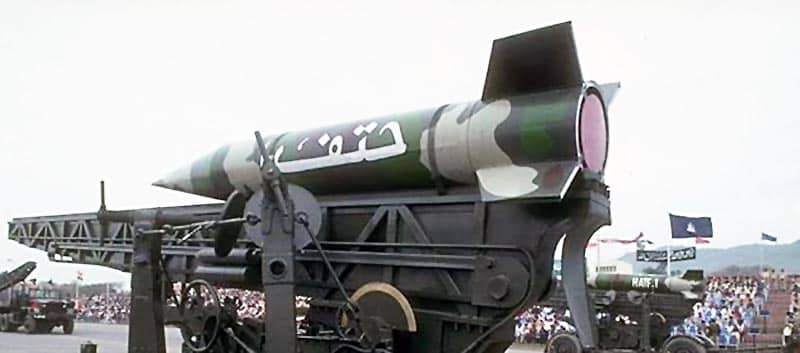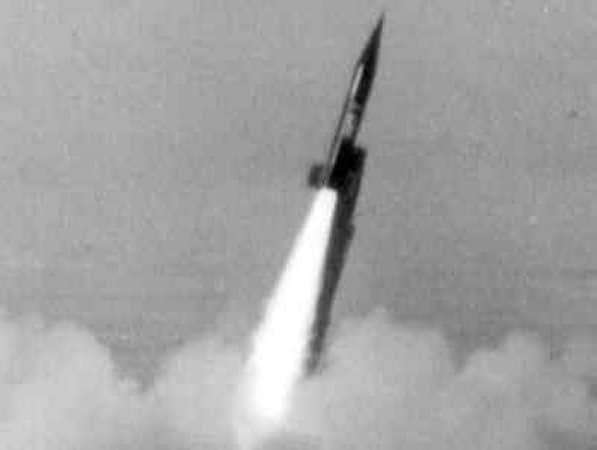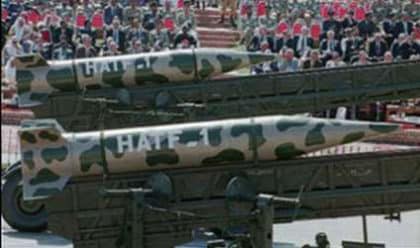The Hatf 1 is a short-range, road-mobile, solid-fueled ballistic missile. There are three versions: the 1, 1A, and 1B.
Hatf 1 at a Glance
- Originated from
- Pakistan
- Possessed by
- Pakistan
- Class
- Short-Range Ballistic Missile (SRBM)
- Basing
- Road-mobile
- Length
- 6.0 m
- Diameter
- 0.56 m
- Launch weight
- 1,500 kg
- Payload
- Single warhead, 500 kg
- Warhead
- Conventional
- Propulsion
- Solid propellant
- Range
- 70 – 100 km
- Status
- Operational
- In Service
- 1992 – present



Hatf 1 Development
Pakistan first revealed the Hatf 1 missile in 1989. The missile and its variants were likely developed with French and Chinese assistance. The missile body is directly derived from France’s Eridan sounding rocket, with several French companies thought to have cooperated with the Pakistani government.1 These units were reportedly assembled with substantial Chinese assistance.2
An upgraded variant designated Hatf 1A reportedly entered service in 1995. It features an increased range of 100 km and improved accuracy.
Specifications
The Hatf 1 is a mobile, tactical system that was revealed by Pakistani officials in 1989 and entered service around 1992. It is ground mobile and can be launched from Transporter-Erector-Launcher (TEL) vehicles.3 The missile has no in-flight guidance, as evidenced by the long launch ramp that accompanies it, making it similar in form to an artillery rocket. This makes Hatf 1’s accuracy poor. Even if properly aimed, it can likely only hit within several kilometers of the target area. The Hatf 1 has a range of approximately 70 km when carrying a 500 kg warhead.4 The Hatf 1 is probably deployed with high explosive or chemical weapons, and although it could theoretically carry a tactical nuclear weapon, Pakistan has declared it to be non-nuclear.5 The missile is single staged, with a diameter of 0.56 m and is 6 m in length. Due to its solid propellant, it is simple to store, transport, and fire.
The Hatf 1B, the final evolution of the Hatf 1, was first flight tested in February 2000. It likely became operational in 2004. The Hatf 1B is probably a Hatf 1A that employs a rudimentary inertial guidance system while retaining the range and payload of the original Hatf 1. Despite the addition of the guidance system, which presumably gives it accuracy in the hundreds of meters CEP, it is still effectively an artillery system.6
Footnotes
- S. Chandrashekar, Arvind Kumar, and Rajaram Nagappa, An Assessment of Pakistan’s Ballistic Missile Programme: Technical and Strategic Capability, (National Institute of Advanced Studies, Bangalore, India, 2006) 7.
- Vipin Narang, “Pride and Prejudice and Prithvis: Strategic Weapons Behavior in South Asia,” in Inside Nuclear South Asia, ed. Scott D. Sagan (Stanford: Stanford University Press, 2009).
- “Hatf 1, in IHS Jane’s Weapons: Strategic 2015-2016, ed. James C. O’Halloran (United Kingdom: IHS, 2015), 69-70.
- “Hatf 1, in IHS Jane’s Weapons: Strategic 2015-2016, ed. James C. O’Halloran (United Kingdom: IHS, 2015), 69-70.
- Arvind Kumar and Michael Vannoni, Ballistic Missile Proliferation in Southern Asia: Options for Stabilization, (Sandia National Laboratories, Cooperative Monitoring Center Occasional Paper 3/4: February 2004) Accessed on http://www.sandia.gov/cooperative-monitoring-center/_assets/documents/sand2004-0317.pdf.
- “Hatf 1, in IHS Jane’s Weapons: Strategic 2015-2016, ed. James C. O’Halloran (United Kingdom: IHS, 2015), 69-70.